How to Conduct a Corporate Training Evaluation (2024)
- Published:
- Updated: May 23, 2024


With modern, digital organizations facing factors such as rapid evolution of new technology and skills, digital transformation, and the cutthroat talent recruiting market, creating an effective employee training program that drives real results is critical for companies.
Effective employee training empowers companies to maintain an edge on their competition, as well as keep their workforce trained and upskilled on the latest industry skills and trends.
As companies continue to heavily invest in their corporate learning and development strategy, it becomes crucial to accurately measure the impact and ROI of these L&D programs.
Training evaluation of your L&D programs provide a regular analysis of their efficiency and effectiveness, benchmark results that allow leaders to improve these programs, and equip L&D leaders with real data to highlight their impact with company executives and maintain buy-in.
The results derived from training evaluations are used to improve training programs and achieve maximum return on training investments.
What Is a Training Evaluation?
Training evaluation is the systematic process of collecting information on how efficient and effective corporate training programs are, and then using that information to improve the training.
Training evaluation involves gathering learner feedback from different sources such as training evaluation surveys, comparing job performance before and after the training, observing employee performance, its impact on organizational goals, etc.
All of this feedback and data helps identify if a training program achieved its intended outcomes, and empowers L&D teams to w improve future training programs accordingly.
Benefits of Training Evaluation
Here are four key benefits of training evaluation:
1. Better training ROI
Companies invest a lot of time and money into employee training programs. In fact, the average cost of employee training is $1,111 per employee in 2022.
Being able to show ROI is essential to prove the value of training. Training evaluation collects feedback and data to demonstrate the quantification of the relation between the benefits of a program and its costs to show the ROI for training.
2. Boosts training effectiveness
A regular training evaluation process brings standardization to the learning strategy. It helps measure training effectiveness, bridges gaps in your training programs, improve overall training material, and ensures the overall quality of training is maintained at all levels to provide a better learning experience.
3. Reveals new training methods or approaches
Training evaluation helps reveal new training approaches that haven’t been considered before. For instance, an employee feedback survey conducted post training might show that classroom-based training sessions take too much time out of employees’ schedules, making them fall behind on their responsibilities.
Insights such as these help L&D teams choose different employee training methods that cater to different employee learning styles to promote higher engagement with training.
4. Holds learners & trainers accountable
A successful training evaluation works as a checkpoint to ensure and measure training effectiveness. A well-laid-out training evaluation holds both trainers and employees accountable to the standard a company sets for their training, helping to guarantee objectives of a training program are met, and there are no compromises on deliverables from any party.
5 Types of Training Evaluation Models
There are several popular models L&D professionals may leverage to evaluate the ROI of their employee learning, training, and development programs. Here are five of the most popular training evaluation models to use in your ROI reporting:
1. The Kirkpatrick 4-Level Evaluation Model
One of the most effective and globally recognized methods of evaluating the results of employee training and learning programs is the Kirkpatrick 4-Level Evaluation Model. It is best known for analyzing and evaluating the effectiveness and results of employee training programs.
The model rates a training program against four levels of criteria:
- Reaction – Measures whether the learners find the training relevant to their job role, engaging, and valuable.
- Learning – Gauges each participant’s learning based on whether learners have developed the intended knowledge, skills, attitude, confidence, and commitment to the training.
- Behavior – Measures whether the learning truly impacted participants and if they are applying them in their daily tasks.
- Results – Measures learning against the organization’s business outcomes, i.e., the KPIs established at the beginning of the training.
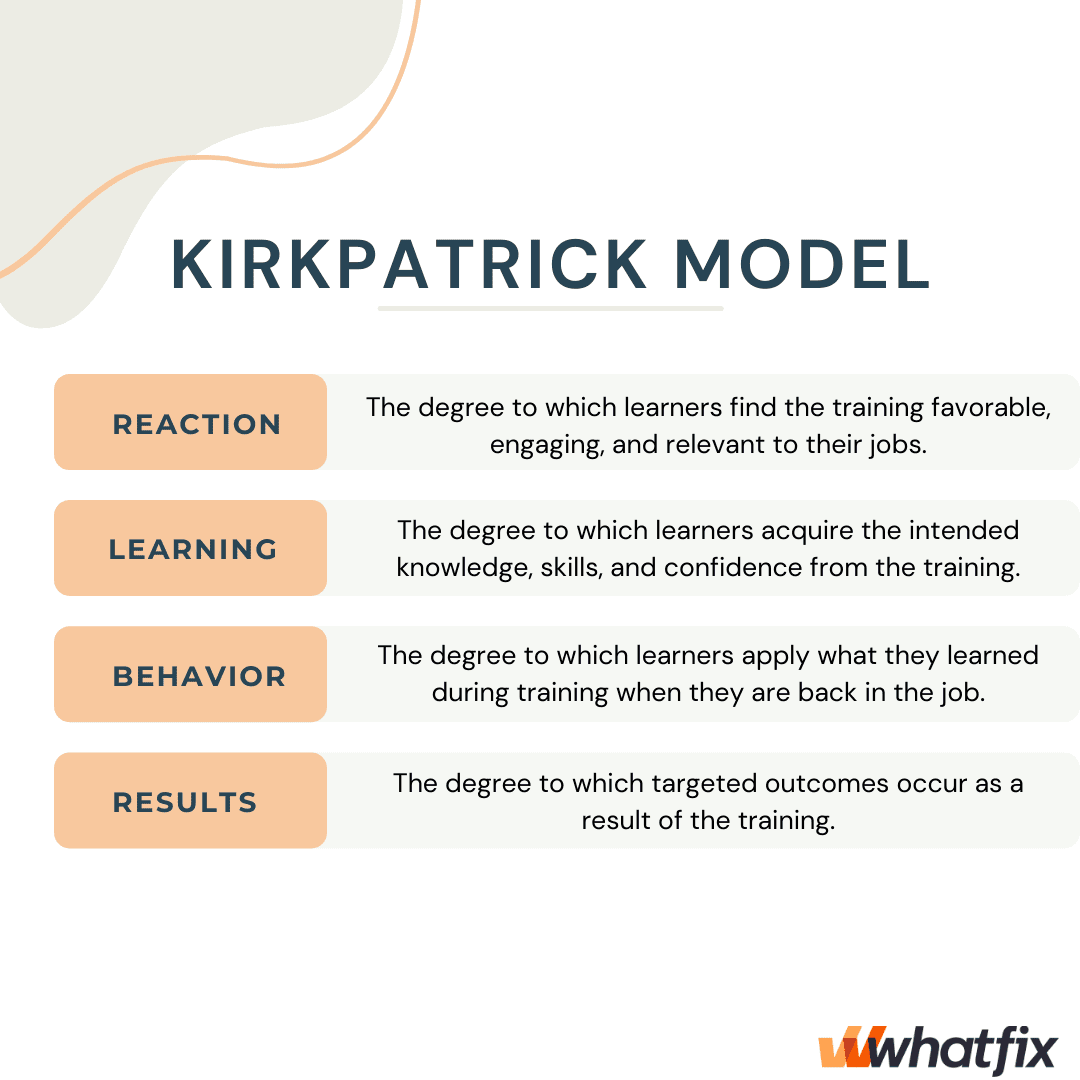
| Measure | Evaluation Description | Tools and Methods | Utilization |
| Participant Reaction | How participants felt about the training or learning experience. | Questionnaire for evaluation of training module and trainers. | Every day at the end of the training session. |
| Participant Learning | Measurement of the increase in knowledge ‐ pre and post training. | Individual pre/post‐training tests for comparison. | Pre and post training. |
| Knowledge Transfer | Extent of applied learning back on the job. | Focus groups to gather information. | At the end of the training course. |
| Organizational Impact | Measurement of the success of the training program. | Facilitator observations. | At the end of the training course. |
2. Phillips ROI Model
The Phillips ROI Model builds on the Kirkpatrick Model. It classifies data from different types employee training programs to measure:
- Reaction – Use short surveys to gather data about participants’ reactions to their training
- Learning – Conduct pre and post-training assessments to interpret learner’s responses and determine how much knowledge they’ve acquired
- Application & Implementation – Unlike Kirkpatrick Model, Phillips Model collects the data to find whether the training was effective and evaluates the WHY behind the success/failure of the training. The Phillips Model adds qualitative feedback to the data process to help organizations improve their training programs.
- Impact – The Phillips ROI model helps analyze the impact of training content and other factors that contribute to participants’ final performance.
- Return on Investment (ROI) – Use cost-benefit analysis to map impact data to tangible monetary benefits and a set of intangible benefits. Training managers use this data to measure and communicate the benefits of their program to other departments in the company and provide hard evidence to executives on the value of training programs.
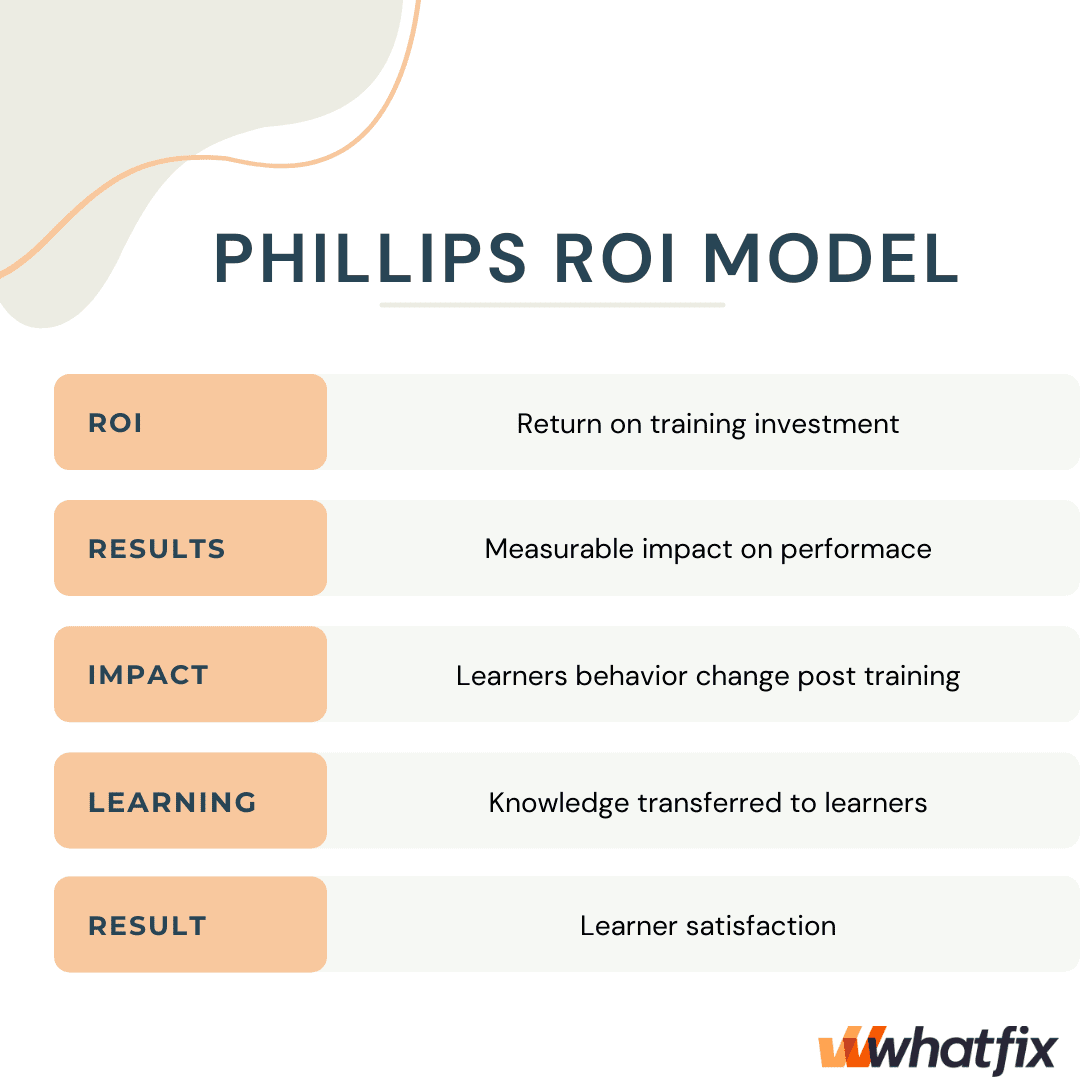
3. CIRO Model
The CIRO (Context, Input, Reaction, and Output) model evaluates the effectiveness of management training courses by focusing on measurements captured before and after the training program.
The training evaluation process is broken into four stages:
- Context – Assesses the organization’s current situation to identify training needs and objectives as:
- The ultimate objective – improve employee performance and productivity, boost profits, or improve customer service.
- Intermediate objectives – achieve positive changes in employees’ work behavior.
- Immediate objectives – employees acquire new skills and knowledge.
- Input – Practitioners of the training evaluation gather information on the possible training techniques and methods. This stage also addresses the training course’s design, planning, management, and delivery.
- Reaction – Information gathered at this stage is used to improve the training program. Trainees give their reactions to the following aspects:
- Training content
- Training approach
- Value-added
- Outcome – The results are measured on the following four levels:
- The learner level
- The workplace level
- The team or department level
- The business level
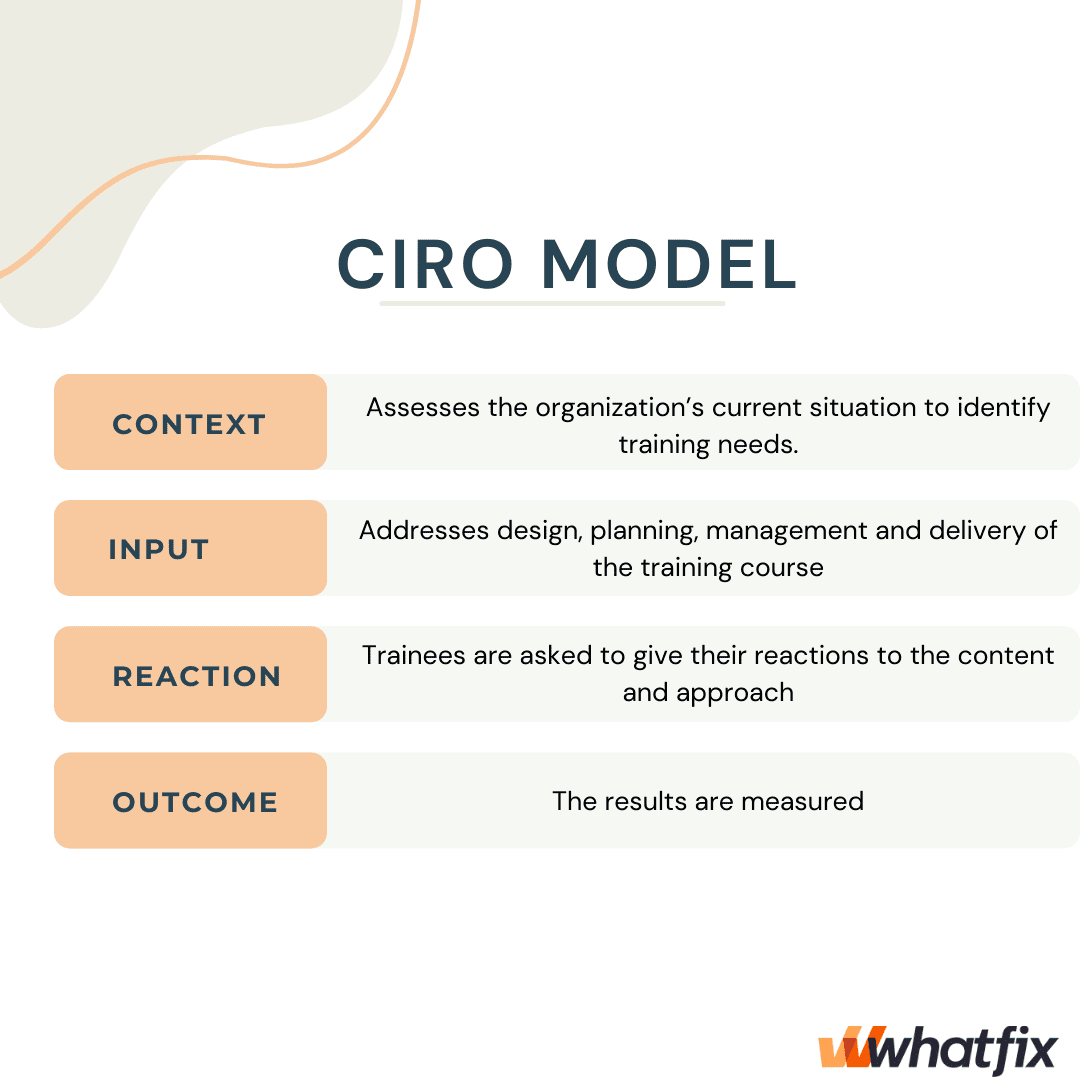
4. Kaufman's Five Levels of Evaluation
Kaufman’s model is another model built on the Kirkpatrick Model. Kaufman’s model is a response, or reaction to, Kirkpatrick’s model and aims to improve upon it in various ways.
Kaufman’s Five Levels of Evaluation are as follows:
- Input – Covers the training materials used to support the training or coaching.
- Process – Measures process acceptability and efficiency.
- Acquisition – Studies whether learners acquired the learning and are using it on the job.
- Application – Evaluates how well participants utilize their learnings in their on-the-job performance.
- Organizational payoffs – Measures payoffs for the organization as a whole. This level includes performance improvement evaluations and a cost-benefit or cost-consequence analysis.
- Societal Outcomes – Measures the societal benefits of the contribution as a whole from and to the client and society’s evaluation.
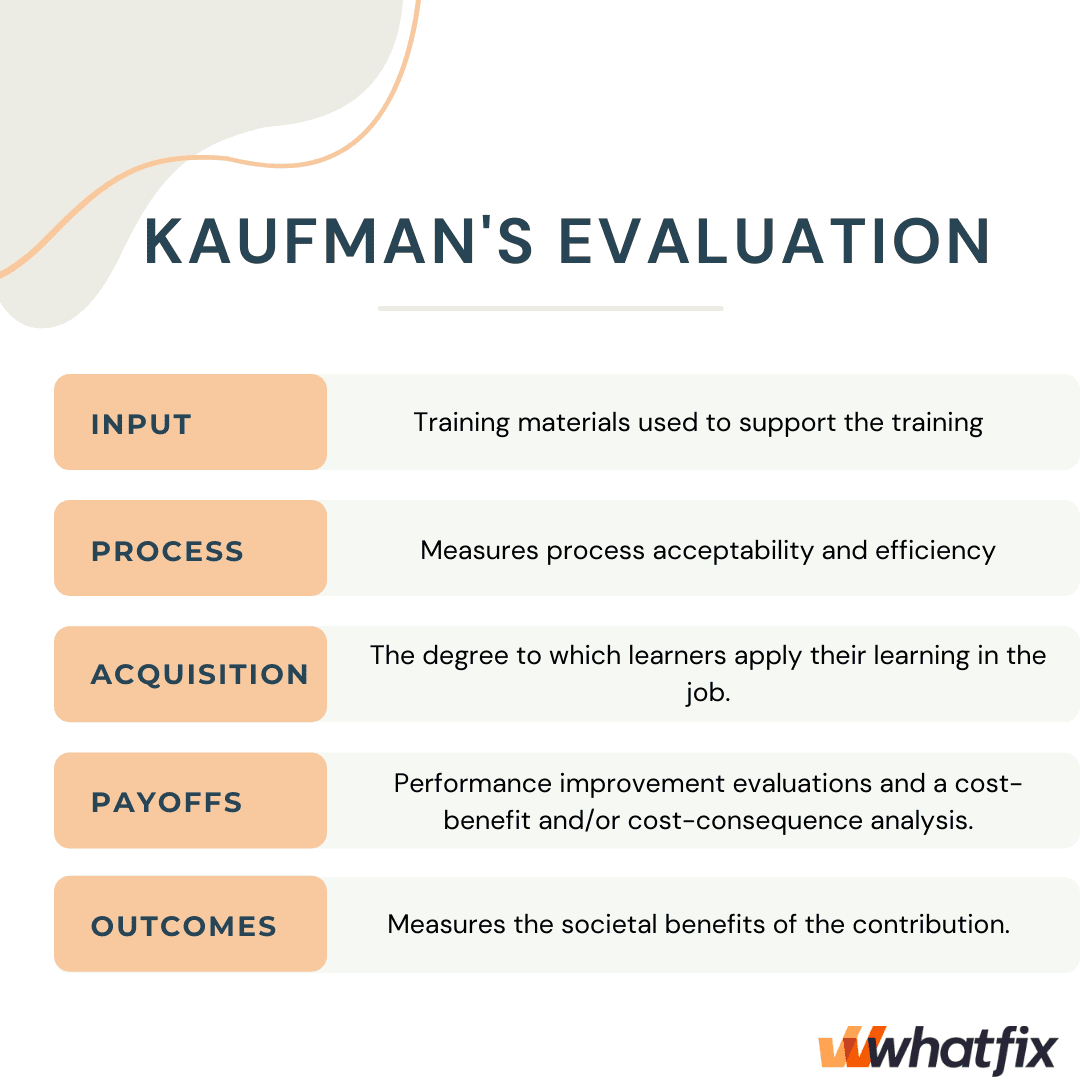
5. Anderson's Model of Learning Evaluation
The Anderson learning evaluation model is a three-stage learning evaluation cycle applied at an organizational level. The model is more concerned with aligning the training goals with the organization’s strategic objectives.
The three cycles are:
- Determining current alignment against strategic priorities.
- Using a range of methods to assess and evaluate the contribution of learning.
- Establishing the most relevant approaches for the organization
How to Evaluate a Training Program in 4 Steps
Here are four simple steps to implement training evaluation into practice for your organization.
1. Determine the indicators of effective training
Before you start with the training evaluation, it is important to determine the indicators of training effectiveness and success.
As a guide, L&D practitioners must answer the question,“in what sense will the training program be considered successful?”
Here are some examples of factors and indicators that will help answer this question and provide a direction in measuring training effectiveness:
- Acquisition of new skills and knowledge
- Employee satisfaction
- Cultural impact
- Financial impact
- Efficiency impact
2. Choose the appropriate ROI model
Different training evaluation models can be implemented to conduct a systematic training evaluation process within the organization. We earlier discussed the five models of training evaluation that have been the most popular and trusted over the years – and any of these are great solutions to help you identify ROI of your training programs.
3. Choose the right method for collecting data
Once the purpose and technique for training evaluation is identified, the next step is to choose the correct method for gathering required information on the training program.
These methods help gather feedback from trainees that have recently participated in the training program to determine areas of improvement and loopholes in the training course.
- Questionnaires – A survey is sent to the participants for your training, both pre and post training, to gather data and feedback on the course. These assessments help to understand the level of new skills and knowledge gained by the trainees.
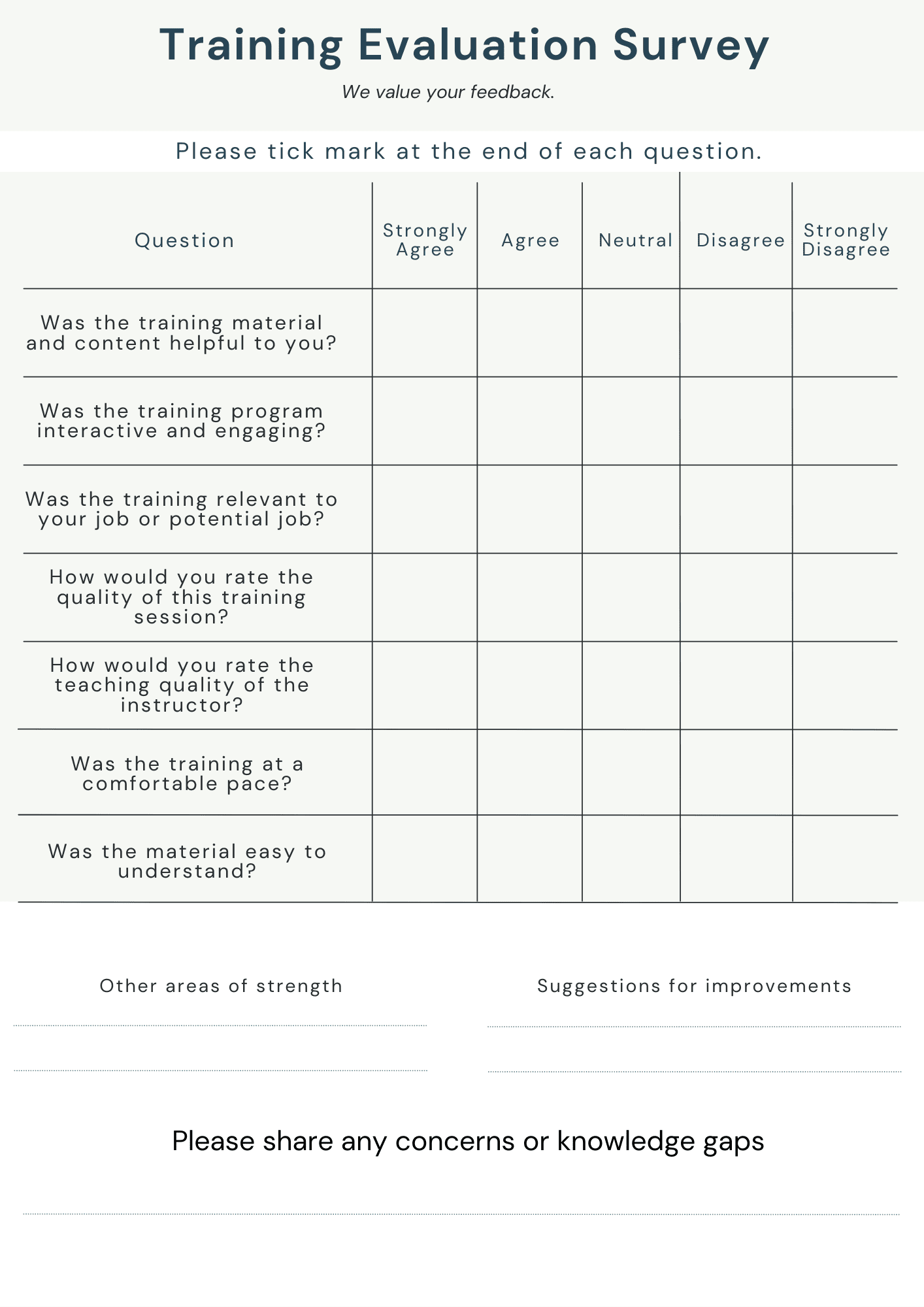
- Interviews – Face-to-face or online interviews allow practitioners to get more qualitative and personalized responses and reactions of training participants on their experience with the training

- Focus groups – Focus groups are facilitated discussions among a small group of participants who participated in the same training program. This method helps gather participants’ insight and feelings towards the training and feedback on how the training can be improved for the future.
- Observations – The observation method is conducted by observing the behavioral change of training participants in a workplace setting. The practitioner or manager observes whether employees use the knowledge gained in the training sessions to complete their daily tasks.
- Data analytics: Use your employee training software or LMS data analytics dashboard to determine how your employees are interacting with the training courses. If a digital adoption platform is used for employee training programs, its analytics dashboard allows for tracking which courses employees are interacting with, how many times they interacted with the course, the average course completion rate, and where employees are dropping off. You can evaluate which courses are most effective or ineffective, useful, interesting, or confusing based on those numbers.
4. Analyze the Data
The final step is to analyze the data collected and document the findings of training evaluation. The record of the training evaluation is a critical component for future improvements in the company’s approach to employee training programs. To document the record, you need to combine and analyze data from different sources and derive meaningful conclusions to determine the effects of training.
Here’s a sample for evaluation of the “reaction” phase using the post-training survey as the evaluation method.
| Question | Strongly Disagree | Somewhat Disagree | Neutral | Strongly Agree | Somewhat Agree |
| I was satisfied with the training course | 6% | 5% | 8% | 38% | 43% |
| The course enhanced my knowledge of the subject. | 5% | 6% | 10% | 40% | 39% |
| The course content was relevant to my job. | 3% | 4% | 15% | 50% | 28% |
| The trainer was able to answer all my queries. | 6% | 10% | 10% | 30% | 44% |
| I would recommend this course to others. | 1% | 1% | 5% | 60% | 33% |
Data Analysis:
Level 1 evaluation results for this training program are:
- Overall satisfaction:
- 81 = respondents who reported “somewhat agree” and “strongly agree” (numerator)
- 100 = total respondents (denominator)
- Enhanced knowledge:
- 79 = respondents who reported “somewhat agree” and “strongly agree” (numerator)
- 100 = total respondents (denominator)
- Content relevancy:
- 78 = respondents who reported “somewhat agree” and “strongly agree” (numerator)
- 100 = total respondents (denominator)
- Trainer feedback:
- 74 = respondents who reported “somewhat agree” and “strongly agree” (numerator)
- 100 = total respondents (denominator)
- Recommendation to Others:
- 93 = respondents who reported “somewhat agree” and “strongly agree” (numerator)
- 100 = total respondents (denominator)
Example of a Training Evaluation Survey
When Is the Best Time to Evaluate Training?
Training evaluation is conducted during the development of the training program or after delivering the program – called formative evaluation and summative evaluation.
Formative Evaluation
The evaluation conducted before training is called formative evaluation.
This type of training evaluation aims to discover issues in a training course and fix them before delivering the training to learners. For formative evaluation, a user acceptance test is run to check whether the online training software is working as intended, or subject matter experts go through the training course to reveal potential errors in the course.
Summative Evaluation
The evaluation conducted post-training is called summative evaluation.
This type of evaluation takes place after learners have completed the training course. For summative evaluation, surveys, interviews, or assignments are used to gather feedback from course participants. This type of evaluation helps make improvements in future training programs.
If you are looking for an effective employee training solution for your corporate training needs, adopt a digital adoption platform like Whatfix.
Whatfix DAP enables you to create scalable employee training flows built directly into your website or enterprise applications – allowing employees to learn in the flow of work.
It provides segmented, contextual training and development self-help resources to employees in the moment of need, with analytics to measure and improve your training processes.
Request a demo to see how Whatfix empowers organizations to improve their employee training programs via interactive walkthroughs and on-demand customer support.
Thank you for subscribing!


